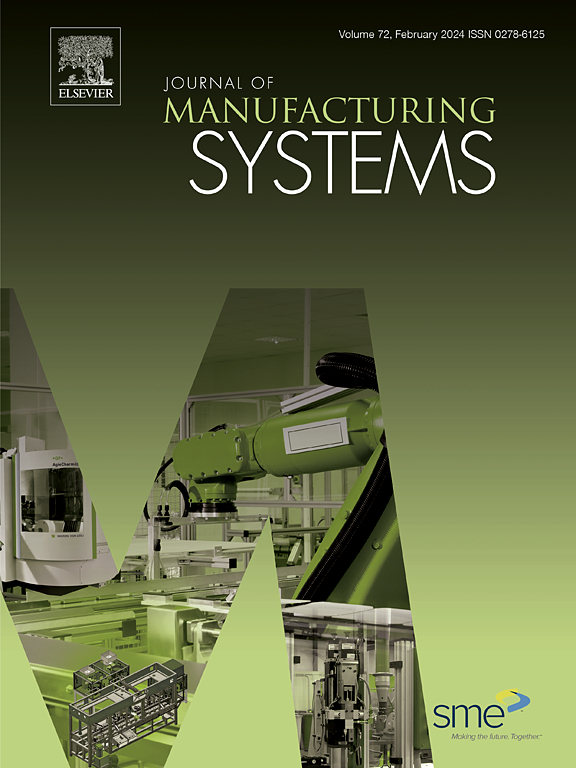Tool digital twin based on knowledge embedding for precision CNC machine tools: Wear prediction for collaborative multi-tool
IF 12.2
1区 工程技术
Q1 ENGINEERING, INDUSTRIAL
引用次数: 0
Abstract
Tool wear prediction is vital for enhancing machining accuracy and ensuring production safety. However, challenges arise from non-processing data interference and missing tool wear samples, complicating the construction of accurate prediction models. Additionally, the complexity of collaborative multi-tool operations on precision computer numerical control (CNC) machine tools, where varying tool types and complex working conditions exist, further exacerbates the difficulty of achieving precise wear prediction. To address these challenges, this paper introduces a digital twin architecture for tool wear prediction, based on knowledge embedding. The proposed architecture is designed to predict the wear of multiple tools, incorporating modules for processing data screening, missing value completion, wear state classification, and so on. On the basis of obtaining high-quality sensing data and complete tool wear values, the wear state and machining process knowledge are embedded into the prediction process. A tool wear prediction model is then constructed based on a Kolmogorov-Arnold integrated time convolutional network (KA-TCN), so as to achieve accurate prediction of multi-tool wear. The effectiveness of the method is validated using data from two grinding wheel wear test platforms and two milling datasets, PHM2010 and NASA. Experimental results demonstrate that the knowledge embedded KA-TCN model outperforms existing approaches, improving prediction accuracy by over 22.4 % on the milling dataset, and by 76.4 % in grinding wheel wear prediction compared to classical methods.
基于知识嵌入的精密数控机床工具数字孪生:协同多工具的磨损预测
刀具磨损预测对于提高加工精度和确保生产安全至关重要。然而,非加工数据干扰和刀具磨损样本缺失带来的挑战使准确预测模型的构建变得更加复杂。此外,精密计算机数控(CNC)机床上多刀具协作操作的复杂性,以及不同刀具类型和复杂工作条件的存在,进一步加剧了实现精确磨损预测的难度。为了应对这些挑战,本文介绍了一种基于知识嵌入的刀具磨损预测数字孪生架构。所提出的架构设计用于预测多种工具的磨损,其中包含处理数据筛选、缺失值补全、磨损状态分类等模块。在获得高质量传感数据和完整刀具磨损值的基础上,将磨损状态和加工过程知识嵌入到预测过程中。然后,基于 Kolmogorov-Arnold 集成时间卷积网络(KA-TCN)构建刀具磨损预测模型,从而实现多刀具磨损的精确预测。利用 PHM2010 和 NASA 两个砂轮磨损测试平台和两个铣削数据集的数据验证了该方法的有效性。实验结果表明,知识嵌入式 KA-TCN 模型优于现有方法,在铣削数据集上提高了 22.4% 以上的预测精度,在砂轮磨损预测方面比传统方法提高了 76.4%。
本文章由计算机程序翻译,如有差异,请以英文原文为准。
求助全文
约1分钟内获得全文
求助全文
来源期刊

Journal of Manufacturing Systems
工程技术-工程:工业
CiteScore
23.30
自引率
13.20%
发文量
216
审稿时长
25 days
期刊介绍:
The Journal of Manufacturing Systems is dedicated to showcasing cutting-edge fundamental and applied research in manufacturing at the systems level. Encompassing products, equipment, people, information, control, and support functions, manufacturing systems play a pivotal role in the economical and competitive development, production, delivery, and total lifecycle of products, meeting market and societal needs.
With a commitment to publishing archival scholarly literature, the journal strives to advance the state of the art in manufacturing systems and foster innovation in crafting efficient, robust, and sustainable manufacturing systems. The focus extends from equipment-level considerations to the broader scope of the extended enterprise. The Journal welcomes research addressing challenges across various scales, including nano, micro, and macro-scale manufacturing, and spanning diverse sectors such as aerospace, automotive, energy, and medical device manufacturing.
 求助内容:
求助内容: 应助结果提醒方式:
应助结果提醒方式:


